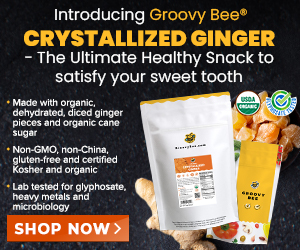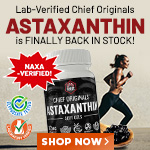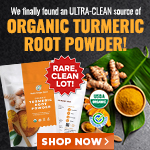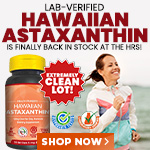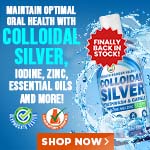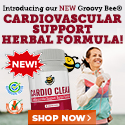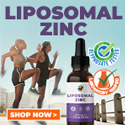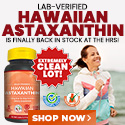
Cut the Chemicals and Enjoy More Energy
Sunday, September 20, 2009 by: Teya Skae
Tags: chemicals, health news, Natural News
- Warp Speed 2.0: Trump Administration ACCELERATES Gates-funded, self-amplifying bird flu vaccines
- DMSO and Natural Dyes: A suppressed cancer treatment resurfaces in independent research
- Transhuman vectors of disease: Young adults continue to produce spike proteins ONE YEAR after receiving COVID vaccine
- Chemical cocktails in processed foods linked to diabetes, validating natural health warnings
- Study finds bananas more effective than salt reduction for lowering blood pressure
- 8 U.S. states may EXPAND vaccine exemptions in 2025, and parents have many reasons to STOP THE SHOTS
- Prominent doctors call for new holistic therapies to address CANCER SPIKE: Tree barks provide anti-cancer treatment options
- Fermented foods like sauerkraut may outshine modern medicine in gut health, research finds
- STAGING BEFORE RELEASE: WHO Runs 2-Day Pandemic Simulation 'Exercise Polaris'
- Aerosolized bioweapons? Strange “diploid biomasses” falling out of the sky in Florida captured under the microscope
- Ancient mummies rewrite human history with “ghost” lineage discovery
- Surge in KIDNEY FAILURES linked to common medications
- Millions of gun owners could be challenged in court and lose their firearms if DOJ doesn’t step in to stop crazy ATF rule
- Mike Adams releases country western hit single: Goin’ Back in Time is Comin’ Home
- Analysis: The coming economic collapse, a mass uprising and Trump's three secret weapons to halt the growing revolt
- Fauci is back in the limelight, and he’s busy promoting a future COVID or FLU pandemic
- Israeli lobbyists boast of controlling US national security policy in leaked AIPAC audio
- Widespread social and economic unrest: Steve Quayle issues urgent financial warning of imminent asset collapse in new interview with Mike Adams
- Israeli lobbyists boast of controlling US national security policy in leaked AIPAC audio
- Aerosolized bioweapons? Strange “diploid biomasses” falling out of the sky in Florida captured under the microscope
- Analysis: The coming economic collapse, a mass uprising and Trump's three secret weapons to halt the growing revolt
- Fauci is back in the limelight, and he’s busy promoting a future COVID or FLU pandemic
- Widespread social and economic unrest: Steve Quayle issues urgent financial warning of imminent asset collapse in new interview with Mike Adams
- Kiss Your Genetic Privacy Good-Bye! 23andMe Gets Green Light to Sell Your Intimate Genetic Details to Anyone They Want
- Mike Adams releases country western hit single: Goin’ Back in Time is Comin’ Home
- U.S. lawmakers investigate Meta over alleged China collaboration
- Tulsi Gabbard leads charge against the Biden regime’s global censorship of the 'Disinformation Dozen'
- Pfizer's RSV vaccine linked to preterm births as drug giant CONCEALED RISKS from pregnant women in unethical clinical trials
- Dane Wigington exposes climate engineering as ‘All-Out Weather and Biological Warfare’
- Shedding light on the dark side of MMR vaccines: How vaccinated individuals SPREAD MEASLES & put the vulnerable at risk
- TAKE IT DOWN Act advances in Congress amid free speech concerns
- CLOT SHOT PLANDEMIC UNFOLDING: Fibrous, rubbery clots caused by covid injections have prion-like seeding activity
- Chemtrails unveiled: How the CIA and Big Business are manipulating the weather for profit
- Curcumin’s ancient healing power supercharges muscle recovery, and its effects are compounded with anti-inflammatory foods and supplements
- Criminal referral requests filed against Fauci and top COVID officials in seven states
- Defunding DEADLY mRNA jabs: Government funding for mRNA technology being scrutinized and sidelined until proven "safe and effective" for real
- Newly released JFK files reveal Pentagon's role in creating Lyme disease and covid in the same lab
- Analysis: The coming economic collapse, a mass uprising and Trump's three secret weapons to halt the growing revolt
- Mike Adams releases country western hit single: Goin’ Back in Time is Comin’ Home
- Aerosolized bioweapons? Strange “diploid biomasses” falling out of the sky in Florida captured under the microscope
- Kiss Your Genetic Privacy Good-Bye! 23andMe Gets Green Light to Sell Your Intimate Genetic Details to Anyone They Want
- European Court of Justice: Healthcare professionals who promoted or administered COVID-19 vaccines are CRIMINALLY LIABLE for any harm caused
- Federal employees whine over DOGE's new directive requiring them to do a 5-point summary of weekly accomplishments
- Widespread social and economic unrest: Steve Quayle issues urgent financial warning of imminent asset collapse in new interview with Mike Adams
- U.S. approves new Russian ambassador as diplomatic thaw continues
- Government waste exposed: Hegseth supports Musk’s demand for accountability from federal workers
- Now you can HEAR chemistry: Health Ranger translates molecules into music in stunning video demonstration that will blow your mind (and your ears)
- Fauci is back in the limelight, and he’s busy promoting a future COVID or FLU pandemic
- CLOT SHOT PLANDEMIC UNFOLDING: Fibrous, rubbery clots caused by covid injections have prion-like seeding activity
- I Want My Bailout Money – new song released by Mike Adams
- I Want My Bailout Money – new song and music video released by Mike Adams
- Tulsi Gabbard leads charge against the Biden regime’s global censorship of the 'Disinformation Dozen'
- Trump administration poised to overhaul crypto regulations with new SEC leadership
- The Health Ranger releases “Vaccine Zombie” song and music video, using AI-animated zombies for the music video
- Red Cross issues warning to stop blood plasma donations from vaccinated people
- Scientists confirm: GENIUS brain function can be spontaneously unleashed in humans without any apparent cause
- EPA advisor admits the agency is funneling billions to climate groups ahead of Trump’s return to White House
- HYSSOP: What research reveals about the health benefits of this ancient holy herb
- Two containers with completed ballots fall out of truck in Florida
- Newly released JFK files reveal Pentagon's role in creating Lyme disease and covid in the same lab
- Global leaders unite to clamp down on “misinformation” with UN-backed Cascais Declaration
- Mike Adams releases country western hit single: Goin’ Back in Time is Comin’ Home
- BREAKING: 2025 NDAA authorizes mandatory military draft of WOMEN across America… as Pentagon pursues global NUCLEAR war with both Russia and China at the same time
- Michael Yon warns of a ZIONIST TAKEOVER in Trump’s second administration
- The Health Ranger releases “Vaccine Zombie” song and music video, using AI-animated zombies for the music video
- Ozempic and Wegovy weight loss drugs are injectable LIZARD VENOM PEPTIDES that may unleash a devastating wave of organ failure… side effects align with symptoms of SNAKE BITES
- BOMBSHELL: DNA testing kits are a SCAM to develop ethnic-specific bioweapons
- Israeli soldiers accused of even more torture and abuse in the West Bank
- I Want My Bailout Money – new song released by Mike Adams
- These 13 countries just signed an agreement to engineer a global FAMINE by destroying food supply
- NASA admits that climate change occurs because of changes in Earth’s solar orbit, and NOT because of SUVs and fossil fuels
- RFK Jr. clears key hurdle: Sen. Susan Collins backs controversial HHS nominee, signaling a new era for health policy
In our quest for wellness and a path to high energy levels it is important to eliminate what our bodies don`t need, chemicals/toxins which are part of everyday life as they exist in foods, cosmetics, toiletries, soaps, perfume, laundry as well as general household products.
Do you know that what you put on your skin, scalp, eyes and gums is absorbed straight into your body`s organs/tissues, cells and even the brain? Put simply, we are ingesting and therefore literally eating many substances that are toxic to our systems and that cause our bodies to slow down in their constant attempt of ridding toxins or to `shove` them into our fat cells for safer storage.
Here is a typical scenario of how chemicals pervade our everyday life. From research in the US (www.ewg.org/skindeep), the average American consumer uses close to 100 toxic chemicals before she/he leaves the house in the morning. In this case, by the time the average consumer leaves their home in the morning, they`ve already poisoned their liver, pancreas, kidneys, heart, lungs and particularly the brain.
We have now come to realise that some brand name dog food is so toxic that it may kill your dog, that toys from China contain dangerous levels of lead, that perfume products can contain as many as 21 different carcinogenic chemicals and that even popular laundry detergent products wash our clothes in a toxic brew of chemicals and artificial fragrances.
The sad truth is that even walking through the aisles of many health food stores in Australia, there are still so called `healthy` products that contain the kind of chemicals that are found in more commercial products.
So what can we do to avoid the trap of buying products that we believe to be ok, and in actual fact, they are not? Simple, before buying and using these products check the ingredients listed. There are numerous consumer websites that provide concise, relevant information on all chemicals typically used and what side effects are. Here is a selection: http://www.health-report.co.uk/ingredients-d...
www.hazard.com/msds
Once you do this exercise, you are on your way to stepping up to becoming a savvy shopper in a world of information overload. It is also helpful to bear in mind that even with all the knowledge and effort, completely avoiding all the chemicals that exist in our world right now is highly unlikely and impossible, unless we live on a desert island with no fuel or modern technology. Yet, the process of cutting out and cutting down on the use of products that contain chemicals, such as those found in deodorants, toothpaste, shampoos, toilet sprays and washing powders, is a great start! The good news is that we have good alternatives to mainstream brands and they work well too. They are usually found on the internet as they do not spend enormous amounts of money on advertising; instead, they just put out good quality products.
To clarify the situation for you, here is a typical list of ingredients on a jar of hand cream: Water, Stearic Acid, Sorbitol, Glycerin, C-12-15 Alkyl Benzoate, Sodium Borate TEA, Cetyl Alcohol, Dimethicone, Aloe Vera, Phenoxyethanol, Propylene Glycol, Quince Extract, Tocopheryl Acetate, Potassium Sorbate, EDTA, Allantoin, Methyl Paraben, Propyl Paraben, Butyl Paraben, Menthol.
The product above is described as containing "natural" herbal extracts. That is misleading marketing as it also contains at least five nasties that really do not belong in a product that masquerades as containing "natural" herbal extracts.
Let's look at one of the most common of these nasties parabens.
Parabens inhibit the growth of bacteria, yeast, and molds and have been used in personal care products such as shampoos, conditioners, deodorants, and sunscreens for years. The main reason for use of parabens is because they allow these products to survive for months, or years, during shipping and on store shelves. Parabens are one of the most commonly used ingredients in personal care products. The only ingredient used more frequently is water.
Studies have now shown that parabens mimic the activity of the hormone estrogen, which is associated with certain forms of breast cancer. http://www.organicconsumers.org/articles/art...
and can lead to diminished muscle mass, extra fat storage, and male gynecomastia (breast growth). http://articles.mercola.com/sites/articles/a...
Parabens are regularly found in shampoos and conditioners, creams and lotions, deodorants and antiperspirants, sunscreens and cosmetics. You can identify parabens on the label, where they may be listed as:
methyl paraben
ethyl paraben
propyl paraben
butyl paraben
isobutyl paraben
E216.
Specific chemical ingredients to avoid:
1,4-dioxane
2-bromo-2-nitropropane-1,3-diol (Bronopol)
Alcohol, Isopropyl (SD-40) Ammonium Laureth Sulfate (ALES)
Ammonium Lauryl Sulfate (ALS)
Anionic Surfactants Benzalkonium Chloride
Butylated Hydroxyanisole (BHA)
Butylated Hydroxytoluene (BHT) Cationic surfactants
Cetalkonium chloride
Chloromethylisothiazolinone & Isothiazolinone Cocoamidopropyl Betaine
Cocoyl Sarcosine
Cyclomethicone DEA (diethanolamine)
Diazolidinyl urea
Dimethicone Disodium Dioctyl Sulfosuccinate
DMDM Hydantoin
Ethoxylated surfactants FD&C Colour Pigments
Formaldehyde
Fragrance Hydrolysed Animal Protein
Imidazolidinyl Urea
Isopropyl PalmitateLanolin
Lauryl dimonium hydrolysed collagen
Lauryl or Cocoyl Sarcosine Lauryl Sarcosine
Liquidum Paraffinum
MEA compounds Methylisothiazolinone
Methylchloroisothiazolinone
Mineral OilNitrosating Agents
Paraben preservatives (methyl, propyl, butyl, and ethyl)
Paraffin wax/oil Polyethylene Glycol (PEG) compounds
Propylene/Butylene Glycol
PVP/VA Copolymer Quaternium-7, 15, 31, 60,
Rancid Natural Emollients
Sodium Cocoyl Sarcosinate Silicone derived emollients
Sodium Hydroxide
Sodium Laureth Sulfate SLES
Sodium Methyl Cocoyl Taurate
Stearalkonium ChlorideTalc
TEA (Triethanolamine) Laureth Sulfate
Toluene
Source: http://www.health-report.co.uk/ingredients-d...
For an even more comprehensive database visit http://www.speclab.com/compound/chemcas.htm
Are all the chemicals found in cosmetics absorbed through the skin?
Yes, but the capacity for absorption varies widely. Some areas of the body such as lips, gums, underarms and around the eyes absorb chemicals more readily than other areas. In addition, many products contain penetration enhancers, chemicals that allow other ingredients to penetrate skin more deeply and quickly.Also chemicals in cosmetics and household cleaners are inhaled or ingested during use. The various `fragrances` contain volatile chemicals. For example, nail polish and nail polish remover contain solvents that are problematic by just inhaling them because nail polish is essentially a solvent-based paint, and nail polish remover is like paint remover.
Baby powder and other powders, as well as aerosol products such as deodorants and hair sprays, may also be inhaled during use. Products that are applied on or around the lips such as lipstick and lip gloss are ingested during application or afterwards. The colours, fragrances and other chemicals typically used in lipsticks go straight to the organs of digestion. The great news is that there are good quality chemical free lipstick ranges that effectively replace traditional coloured lipstick.
What is the story on phthalates and how can I avoid them?
Phthalates are plasticising chemicals that have been called "the everywhere chemicals" because they are used in so many types of products such as food wraps and many pliable plastics and containers. Also used in hairsprays and some cosmetics including nail varnishes from where they are readily absorbed into the system. Phthalates are implicated with low sperm counts and also causing sexual abnormalities and deformities and are also linked with asthma, and kidney and liver damage. Phthalates are common ingredients in fragrances (such as perfumes and colognes) and many products containing fragrance, as well as nail polishes and treatments.
Avoid fragrances and products listing "fragrance" as an ingredient (this can include a wide variety of products such as deodorant, soap, hair products, skin care products, and makeup). Products that claim to be "fragrance-free" on packaging may contain masking fragrances to cover the odor of other ingredients; make sure that the ingredient list doesn`t include "fragrance". Also avoid products that list phthalates in the ingredients: look out for nail polishes and treatments in particular, which often contain dibutyl phthalate (DBP).
What can we use instead of fragrances?
The purest of purest organic essential oils make exquisite fragrances. Oils such as jasmine, sandalwood, frankincense and bergamot can all be used as a fragrance in an aerosol spray for the bathroom or kitchen, and they can be used as antibacterial agents in soaps, even creams for the face and body.
It is important to be aware that a lot of essential oils on the market use chemicals and can cause headaches, skin irritations and even toxic reactions so it is really important to only use the oils that are 100% pure, organic, therapeutic and unadulterated.
Is it true that some hair dyes contain lead?
Yes. Some gradual hair colors contain lead acetate. Lead is an extremely toxic chemical that harms children`s intelligence, and no safe level of exposure has been found. In addition, high levels of lead create artificial anemia as lead lowers the bioavailability of iron in the body. That is we can be eating a high meat intake and still have an iron deficiency because of the high levels of lead in our cells.
Hair coloring products are among the most hazardous cosmetics. Least dangerous are probably the temporary dyes. Permanent dyes contain a mixture of potent chemicals that can cause skin, eye, or respiratory irritation. Many coal tar colors used in some hair dyes are carcinogenic and products containing them are best avoided.
You can research products that you are using, or considering using, in the Environmental Working Group www.ewg.org Skin Deep Database. This database ranks thousands of products based on their safety.
Are antimicrobial hand soaps better than ordinary hand soaps?
Not at all. Washing hands with hot water and plain soap is just as effective. Antibacterial soaps have little effect against viruses and therefore don`t protect against colds or the flu any more than ordinary soap.
How do I find better alternatives and safe products?
Chemical-free products exist and most of them can be purchased from online websites. Initially, it might seem time consuming to search and read all the labels and to start getting familiar with the chemicals found but in the end, it is worth the effort, as it is about our health and energy levels.
In summary to increase energy and build on health start eliminating products that contain chemicals and assist the body in excreting the already built up chemicals load. Spend some time before buying on researching chemical-free alternatives as an important exercise in not only becoming a smarter consumer but becoming aware of misleading marketing statements used to sell products that at the end of the day are just promoting products with chemicals. In cosmetics particularly, these products promise diminishing signs of ageing. How is that possible, when in fact the chemicals found in these products do in fact accelerate the process of internal ageing of the cells, organs and tissues?
Fortunately, there are companies that employ high ethics and integrity in formulating and delivering ranges of organic/chemical-free products and most of them may be found on the web. Before trying these products check the ingredients by referring to the various databases (mentioned above). In addition, ask via email if any other ingredients are used in their products. All of this makes a difference to our health as good health is not so much about what we put in as what we take out, and it starts with what we don`t need - toxic chemicals.
In Wellness
Teya Skae
References
www.ewg.org
http://hermes.erin.gov.au/pls/cig_public/!CI...
http://www.speclab.com/compound/chemcas.htm
Cosmetics Ingredient Review (CIR) (2003). 2003 CIR Compendium, containing abstracts, discussions, and conclusions of CIR cosmetic ingredient safety assessments. Washington DC.
Cosmetics Ingredient Review (CIR) (2004). CIR information available at http://www.cir-safety.org, accessed May 6 2004.
Department of Trade and Industry, UK (DTI) (1998). A survey of cosmetic and certain other skin-contact products for n-nitrosamines.
About the author
Teya Skae M.A. ATMSCorporate Wellness Presenter/Researcher and Author
As the founder of Empowered Living Teya has developed a results based I.D.E.A.L Solutions for increasing your energy, focus and personal Success!
Teya is also a QUIT smoking specialist with proven results in one session guaranteed.
For Tangible Results and Solutions to Fat Loss, Physical, Emotional and Mental Fitness visit
www.empowered-living.com.au
Chemicals at FETCH.news
Get independent news alerts on natural cures, food lab tests, cannabis medicine, science, robotics, drones, privacy and more.
Take Action: Support Natural News by linking to this article from your website
Permalink to this article:
Embed article link: (copy HTML code below):
Reprinting this article:
Non-commercial use OK, cite NaturalNews.com with clickable link.
Follow Natural News on Facebook, Twitter, Google Plus, and Pinterest
Science News & Studies
Medicine News and Information
Food News & Studies
Health News & Studies
Herbs News & Information
Pollution News & Studies
Cancer News & Studies
Climate News & Studies
Survival News & Information
Gear News & Information
News covering technology, stocks, hackers, and more



"Big Tech and mainstream media are constantly trying to silence the independent voices that dare to bring you the truth about toxic food ingredients, dangerous medications and the failed, fraudulent science of the profit-driven medical establishment.
Email is one of the best ways to make sure you stay informed, without the censorship of the tech giants (Google, Apple, Facebook, Twitter, YouTube, etc.). Stay informed and you'll even likely learn information that may help save your own life."
–The Health Ranger, Mike Adams










